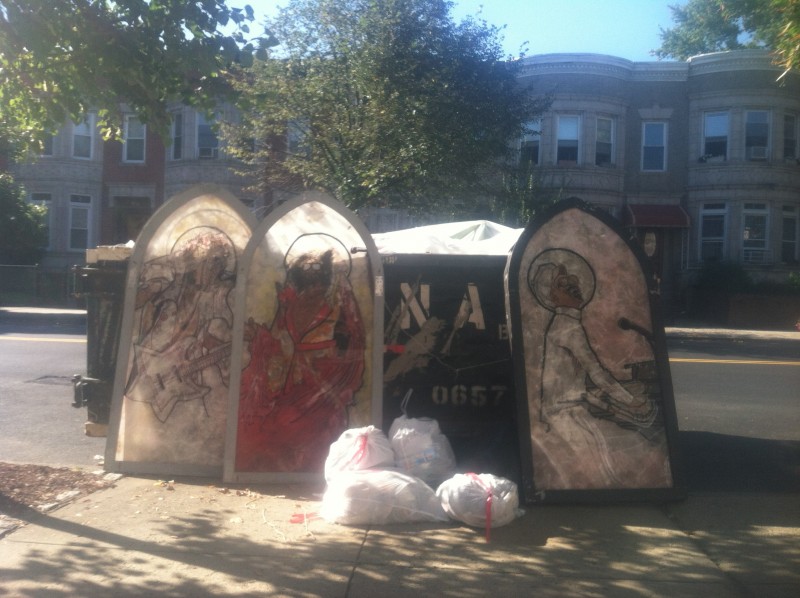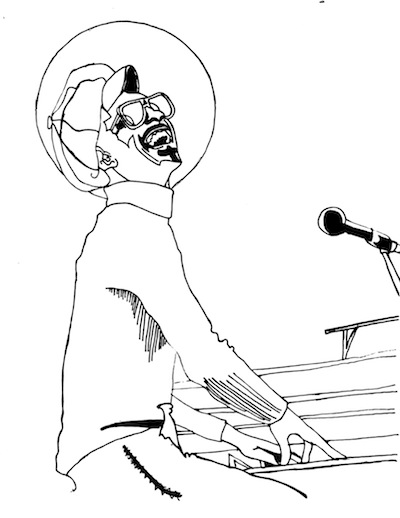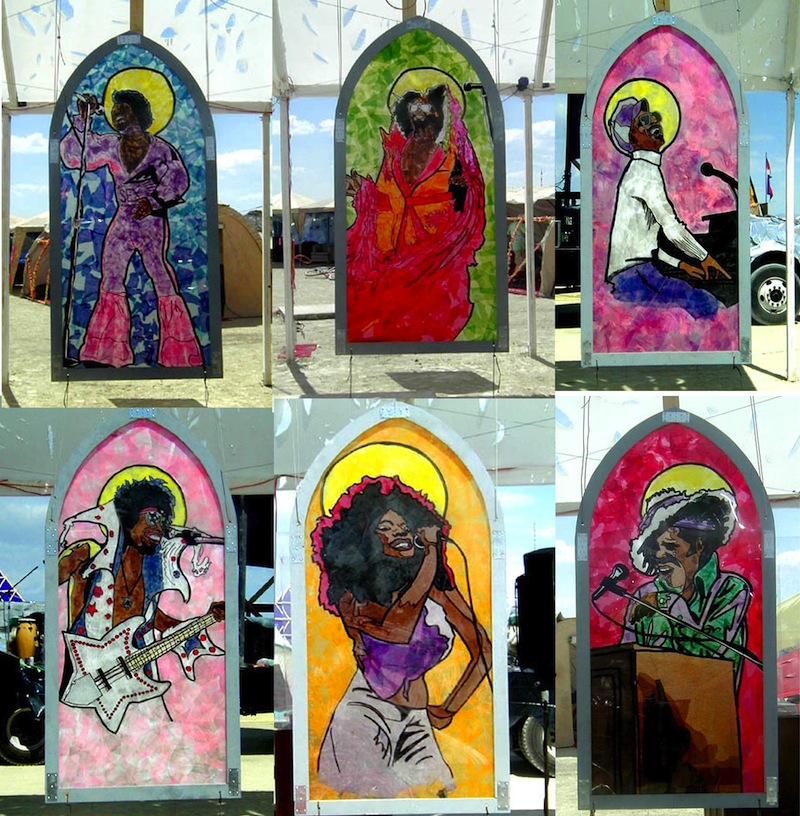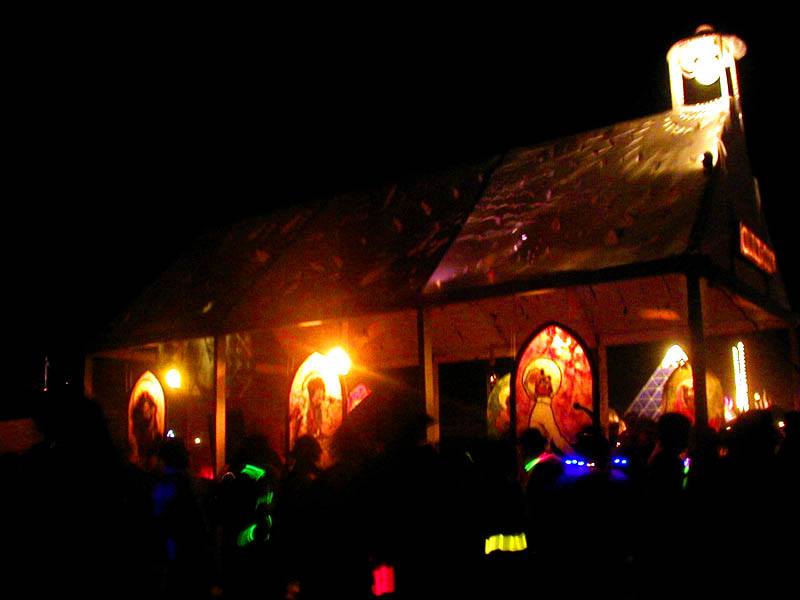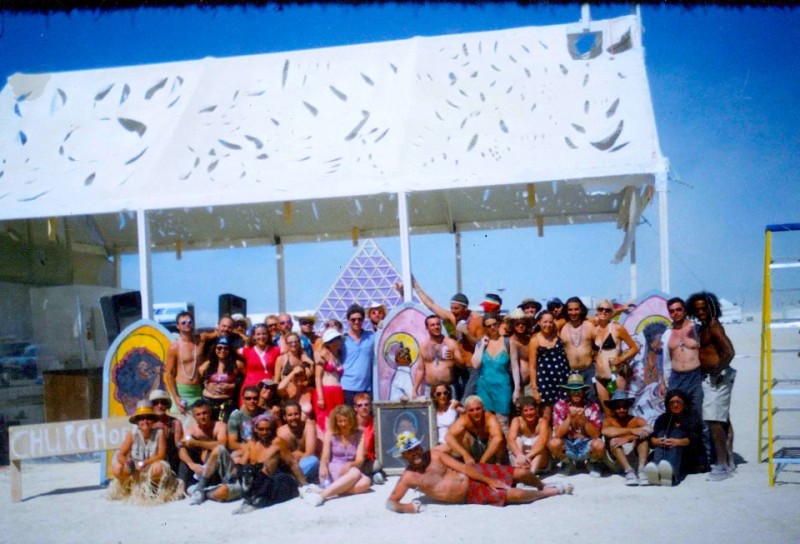But that was a long time ago — the late ’90s and early ’00s, to be precise — and parenthood and geography and the rising costs of the objectively ridiculous particulars of surviving in an unambiguously hostile climate have combined to keep me away.
Whatever lingering desire I may have had to go out there again was strangled last year, when one of my best friends, with whom I attended all six of my burns back in the day, came back and reported that he’d waited in line in his car for eight hours to get into the event. That was pretty much a wrap on Burning Man for me, at least until I can afford to parachute in. (The soaking rain that closed the gate for a day earlier this week, and exacerbated the already ridiculous wait for Will Call tickets, was just the icing on the No Thank You cake.)
This week was also the week that we finally got our contractor to show up and do the job that we agreed on in the spring: removing our old backyard fence and replacing it with a nicer, taller one, fixing a piece of rusted-out crown molding at the edge of the roof, and taking away the four barrels full of dirt in the center of the yard. (The boy and I are playing a lot of catch these days and those barrels are in the way.)
Disposal of all this stuff required that we rent a dumpster and have it parked out front for a couple of days, which I saw as an opportunity to get rid of some of the considerable amount of clutter our basement and back yard have accumulated. The old AC unit, the scrap wood, the old paint cans… I asked my wife what else we should toss.
“The windows?” She said this tentatively, knowing I didn’t want to hear it, but also knowing that this was not the first time she had made this suggestion.
The windows she referred to are the fake stained-glass windows I made (with her help) for The Church of Funk, the culmination of our four-year effort to bring funk music to Burning Man. In 1998, my first burn, my friends and I had an amazing time but couldn’t help noticing that the music, an unending thump of terrible late-’90s techno, could stand some improvement. In ’99, we formed a band and put it on the back of a flatbed truck and played embarrassingly sloppy versions of a half-dozen James Brown and Meters tunes. People loved it anyway. In 2000, we built a whole camp around it, complete with lighted SATURDAY NIGHT FEVER dancefloor, we expanded the band, we learned more tunes, we upgraded the truck with a life-size flying saucer hovering over the drum riser, and people followed us all over that desert. In 2001, it seemed like there were a lot more people playing funk on the desert. In 2002, we decided to raise our game.
The Church of Funk was a house frame with a peaked roof and no walls, with more lighted dance floors, a a DJ booth/pulpit in front, and (to make it like a real church) a basketball hoop on the back.
I took on the job of creating the “stained glass” windows for the Church. I had a vision: the design of the Church had four upright supports on two sides, so each of the gaps would be filled by a window, three on each side, depicting the saints: James Brown, Bootsy Collins, George Clinton, Stevie Wonder, Sly Stone, and Chaka Khan. The gaps were big, probably ten feet wide by twelve feet tall, so the windows would be big, too — three feet wide by six feet tall, peaked at the top.
The only trouble was I had no idea how to do it. Making real stained glass was obviously not feasible, so we decided to use plexiglas. But the problem of how to get convincing likenesses of all these famous faces onto that plexiglas was something I had to think about for a while.
First, I found black-and-white photos of the saints that fit the bill. These came from different sources: web searches, books, album covers. I put tracing paper over the photos and traced simplified versions, leaving out unimportant small details, trying just to get the essence of each, of course adding halos to each saint. Then I traced over the tracings with a Sharpie and erased the pencil marks.
Then I scanned the result into Photoshop and boosted the brightness and contrast to make it all black and white with no grey or erasermarks. I also experimented with color schemes by using the paint bucket tool.
Once I was satisfied that I had the images I wanted, I traced the traced tracings again, this time onto transparency film. I borrowed a friend’s overhead projector (like they used to use in math class) and projected each transparency onto the plexiglas. The plexiglas came with paper stuck to both sides, to keep it from getting scratched; this turned out to be useful. I took the paper off of one side and projected the image onto the other, then traced each image one last time with a big permanent black marker on the unpapered side.
The final step was to add some color, and I still didn’t know how I was going to do that. I researched different kinds of paint, trying to find one translucent enough to let light through like a stained glass window, but nothing seemed like it would really work. My wife finally supplied the solution: to glue colored tissue paper to the plexiglas with Mod Podge. This was a genius idea and it worked perfectly. So to do James Brown’s face, for example, I took a piece of brown tissue paper and laid it over the drawing on the plexiglas, traced the face and cut it out, then soaked it in Mod Podge and put it in place. If I wanted part of the face to be darker or shadowed, I’d add another layer of paper.
There was definitely a learning curve with this part of the project. If I have any regret about how it all turned out, it was that I did the James Brown window — obviously the most revered of the saints — first, before I really had my technique down. James turned out all right, and so did Bootsy, who I did second, but I really hit a groove on George Clinton (#3) and Stevie Wonder (#4), which turned out to be my two favorites.
By the time I got to the last two, Chaka Khan (#5) and Sly Stone (#6) I was pretty sick of the project, as I had been working all day on this for about two weeks, and I kind of rushed through them. They also turned out fine — a lot of people said Chaka was their favorite — but I felt the difference was apparent.
Next I had to make the frames, which I cut out of plywood using a jigsaw, and paint them a grey that suggested the stonework in an old church. We all drove out to Reno to construct the church before the burn, and while everyone else was working on that I was finishing the windows, attaching the frames to the plexiglas and drilling holes in the frames so they could be hung. Since the frames were made in pieces, I made the mistake of picking one of the windows (Bootsy) up by the point, and the thing snapped neatly in half along the seam between frame pieces. I had put so much time into these things by that point that I almost cried. In the end I patched it with a piece of clear packing tape and almost nobody noticed the break.
Once we got the windows up in the Church, with clip lights at top and bottom, they looked amazing. The whole Church was amazing. We fucking won Burning Man that year. Now that people are spending millions of dollars on their camps I’m sure that any recent attendee of the burn would be unimpressed by all this, but at the time this was as good as it got. DJs we never met were lining up to spin in there, the dancefloor was packed 100% of the time. The best time I ever had DJing was in there — people just kept saying “Thank you, thank you.”
Toward the end of the week someone found me lounging around one afternoon and asked if I was the one who made the windows — he had been pointed my way by someone else at our camp. I said I was, and the guy said he friend owned 1015 Folsom, a very busy dance club in San Francisco, and wanted to buy the windows to hang in the club. I had never considered selling them because it had never occurred to me that anyone would want them. I gave the guy my number and started discussing with the other Funkcampers what would be an appropriate price for the windows: $200 each? $500? $600 each, $3,000 for the set?
Alas, the guy never called. But the idea that the windows should live on in a dance club stuck in my mind, so that when I started working at a very busy rock club in New York a couple of months later I tried to interest the owners in the windows. They looked best when light was coming through them so I took my favorite of the windows — Stevie Wonder — and turned it into a light box, so that it could be hung on a wall and still illuminated. I brought the result back to the bar, hoping to leave with an order for five more just like it, and they said they had changed their mind.
For a while I didn’t have anywhere to store the windows, and I kept them in the basement at another bar I was working at, in Brooklyn, until that bar sold and I had to move them again. Sly Stone had been broken at some point while they were there. By then I had a house with a basement, so they went down there for a while until they got in the way, and eventually landed in the back yard, which is where they’ve been for the last seven or eight years, fading in the sun, paint chipping, wood rotting.
So when my wife suggested I toss them in the dumpster yesterday I instinctively flinched, but I knew it was time. “You’d make a terrible set designer,” she said. “When the play is done, you strike the set and put everything in the trash and move on to the next production.” She’d told me this a number of times and it had never worked, so she tried another tack: “It’s kind of like the high-school quarterback wearing his letter jacket into his 20s.”
That one stung a little.
So when I woke up this morning I finally did it. I put them in the dumpster. They were in pretty rough shape. Bootsy and Chaka were stuck together, their 12-year-old Mod Podge melting together in the sun. George Clinton had a big crack in it. Stevie, my favorite, was the only one intact, but its colors were badly faded and the big lightbox, which had seemed like such a good idea at the time, was just big and heavy and rotting, and I didn’t see any easy way to separate the box from the original window.
I’m not sure why I held onto these things for so long; I guess they were the trophies from the most fully realized artistic expression I ever had. But I finally had to face it: I’m not going back to the desert, and even if I do, these things are not coming with me. Better to remember them like they were than to let them degrade any further before our eyes.
As I was carrying them out even my wife almost had a change of heart. “Maybe we should just keep Stevie,” she said. “These things are so cool.”
“Nah,” I said, “let’s just get rid of it. We have plenty of pictures.”
I’ve long since moved on to the next production, and the next, and the next after that. Time to strike the set.

